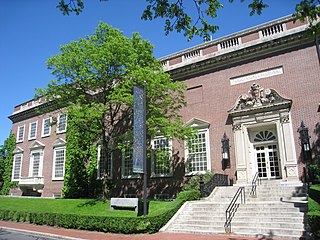
The Six Steeds of Zhao Mausoleum are six Tang (618–907) Chinese stone reliefs of horses which were located in the Zhao Mausoleum, Shaanxi, China. Zhao Mausoleum is the mausoleum of Emperor Taizong of Tang.

The German Research Foundation is a German research funding organization, which functions as a self-governing institution for the promotion of science and research in the Federal Republic of Germany. In 2019, the DFG had a funding budget of €3.3 billion.

Langdon Warner (1881–1955) was an American archaeologist and art historian specializing in East Asian art. He was a professor at Harvard and the Curator of Oriental Art at Harvard’s Fogg Museum. He is reputed to be one of the models for Steven Spielberg's Indiana Jones. As an explorer/agent at the turn of the 20th century, he studied the Silk Road. He was elected a Fellow of the American Academy of Arts and Sciences in 1927.
Victor Henry Mair is an American sinologist. He is a professor of Chinese at the University of Pennsylvania. Among other accomplishments, Mair has edited the standard Columbia History of Chinese Literature and the Columbia Anthology of Traditional Chinese Literature. Mair is the series editor of the Cambria Sinophone World Series, and his book coauthored with Miriam Robbins Dexter, Sacred Display: Divine and Magical Female Figures of Eurasia, won the Sarasvati Award for the Best Nonfiction Book in Women and Mythology.
Lothar Ledderose is a German professor of the History of Art of Eastern Asia at the University of Heidelberg. A renowned authority in his field, he received the prestigious Balzan Prize in 2005.

The Harvard Art Museums are part of Harvard University and comprise three museums: the Fogg Museum, the Busch-Reisinger Museum, and the Arthur M. Sackler Museum, and four research centers: the Archaeological Exploration of Sardis, the Center for the Technical Study of Modern Art, the Harvard Art Museums Archives, and the Straus Center for Conservation and Technical Studies. The three museums that constitute the Harvard Art Museums were initially integrated into a single institution under the name Harvard University Art Museums in 1983. The word "University" was dropped from the institutional name in 2008.

Berthold Laufer was a German anthropologist and historical geographer with an expertise in East Asian languages. The American Museum of Natural History calls him, "one of the most distinguished sinologists of his generation."
John Max Rosenfield was an American art historian, with a specialization in Japanese art.

Hubert Vos was a Dutch painter who was born Josephus Hubertus Vos in Maastricht. He studied at the Académie Royale des Beaux-Arts in Brussels and with Fernand Cormon in Paris. He exhibited widely in Paris, Amsterdam, Brussels, Dresden and Munich. From 1885 to 1892, he worked in England, where he exhibited at the Royal Academy between 1888 and 1891. He was a member of the Royal Society of British Artists.
Wang Ziyun was a Chinese oil painter, sculptor and archaeologist, born in Xuzhou, Jiangsu, China.

A jia is a ritual vessel type found in both pottery and bronze forms; it was used to hold libations of wine for the veneration of ancestors. It was made either with four legs or in the form of a tripod and included two pillar-like protrusions on the rim that were possibly used to suspend the vessel over heat. The earliest evidence of the Jia vessel type appears during the Neolithic Period. It was a prominent form during the Shang and early Western Zhou dynasties, but had disappeared by the mid-Western Zhou.
Robert Bagley is a professor of Chinese art history and archaeology in the Department of Art and Archaeology at Princeton University.
Seymour Slive was an American art historian, who served as director of the Harvard Art Museums from 1975 to 1984. Slive was a scholar of Dutch art, specifically of the artists Rembrandt, Frans Hals, and Jacob van Ruisdael.

Alan Michael Wachman was a scholar of East Asian politics and international relations, specializing in cross-strait relations and Sino-U.S. relations. He was a professor of international politics at The Fletcher School of Law and Diplomacy, Tufts University. Previously he had been the co-director of the Johns Hopkins University-Nanjing University Center for Chinese and American Studies in the PRC, and the president of China Institute in America.
James Francis Cahill was an American art collector and historian who taught at the University of California, Berkeley. He was considered one of the world's top authorities on Chinese art.

The Sino-German Center for Research Promotion (SGC) is a research funding institution based in Beijing, established by the German Research Foundation and the National Natural Science Foundation of China (NSFC).

Sheng-Ching Chang is a Taiwanese art historian. She serves as the director of the Graduate Institute of Museum Studies at Fu Jen Catholic University and the professor at the Department of History of Fu Jen Catholic University in Taipei.
Jakob Rosenberg was an art historian, museum curator, and educator who is noted particularly for published work on Rembrandt. He was active in Germany until his 1937 emigration to the United States, where he joined the faculty of Harvard University. In addition to his professorship he was the curator of prints at the Fogg Museum. Rosenberg retired in 1964, but continued his scholarly activities until his 1980 death in Cambridge, Massachusetts.
Ludwig Bachhofer was a German art historian and professor in Munich and at the University of Chicago.
Loehr is a surname of German origin. Notable people with the surname include:










